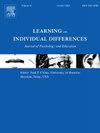Early predictors of mathematics learning difficulty in rural Chinese children
IF 3.8
1区 心理学
Q1 PSYCHOLOGY, EDUCATIONAL
引用次数: 0
Abstract
Mathematics learning difficulty (MLD) can be manifested in the early years of primary school, yet its early indicators remain largely unexplored, particularly in the context of rural children. This study sought to address this gap by investigating the early predictors of MLD in rural Chinese children. The first wave of assessments conducted on 106 rural preschoolers (aged 40–60 months) encompassed IQ, spatial skills, short-term and working memory, visual attention, and vocabulary. Two years later, in Grade 1, their mathematics achievement was assessed, leading to the identification of 26 children with MLD (25 % percentile cut-off). After adjusting for age, it was found that children with MLD scored lower on preschool measures of spatial skills and visual attention compared to their typically achieving peers. Logistic regression analyses further revealed that lower preschool visual attention scores were indicative of a higher MLD probability in Grade 1. Also, a longer duration of boarding preschool attendance was associated with a lower MLD probability. This study thus provides novel insights into early cognitive and contextual factors that contribute to the later identification of MLD in rural Chinese children.
Educational relevance and implications statement
The present study revealed that disparities in spatial skills and visual attention, measured in preschool, differentiated rural Chinese children with and without mathematics learning difficulty (MLD). Additionally, visual attention and boarding school experience during preschool appeared to be uniquely predictive of the likelihood of MLD two years later. Practically, visual attention could be considered to be included in the early screening tools to detect children potentially at risk of developing MLD, at least in rural Chinese settings. Moreover, despite concerns about the well-being of children receiving institutionalized residential childcare at a young age, the practice of boarding during preschool in rural China appears to exert some beneficial effects on children's math development.
数学学习困难(MLD)可在小学低年级表现出来,但其早期指标在很大程度上仍未被探索,尤其是在农村儿童的背景下。本研究试图通过调查中国农村儿童数学学习困难的早期预测指标来弥补这一空白。研究对106名农村学龄前儿童(40-60个月)进行了第一轮评估,评估内容包括智商、空间技能、短期记忆和工作记忆、视觉注意力和词汇量。两年后,在一年级时,对他们的数学成绩进行了评估,最终确定了 26 名患有小儿麻痹症的儿童(百分位数为 25%)。在对年龄进行调整后发现,与成绩一般的同龄儿童相比,患有小儿麻痹症的儿童在学前空间技能和视觉注意力方面的得分较低。逻辑回归分析进一步显示,较低的学前视觉注意力得分预示着一年级有较高的 MLD 概率。此外,在寄宿学前班就读的时间越长,患失智症的概率就越低。本研究揭示了学龄前儿童在空间技能和视觉注意力方面存在的差异,这些差异区分了有数学学习困难(MLD)和没有数学学习困难(MLD)的中国农村儿童。此外,学前时期的视觉注意力和寄宿学校经历似乎对两年后出现数学学习困难的可能性具有独特的预测作用。实际上,至少在中国农村地区,视觉注意力可被视为早期筛查工具的一部分,以发现有可能患上小儿麻痹症的儿童。此外,尽管人们对幼年时接受机构寄宿式保育的儿童的健康状况表示担忧,但在中国农村地区,学龄前寄宿的做法似乎对儿童的数学发展产生了一些有益的影响。
本文章由计算机程序翻译,如有差异,请以英文原文为准。
求助全文
约1分钟内获得全文
求助全文
来源期刊

Learning and Individual Differences
PSYCHOLOGY, EDUCATIONAL-
CiteScore
6.60
自引率
2.80%
发文量
86
期刊介绍:
Learning and Individual Differences is a research journal devoted to publishing articles of individual differences as they relate to learning within an educational context. The Journal focuses on original empirical studies of high theoretical and methodological rigor that that make a substantial scientific contribution. Learning and Individual Differences publishes original research. Manuscripts should be no longer than 7500 words of primary text (not including tables, figures, references).
 求助内容:
求助内容: 应助结果提醒方式:
应助结果提醒方式:


